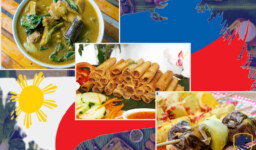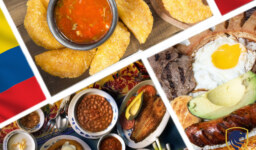Being the home to one of the most popular BBQ cultures, Brazil has a unique and flavorsome cuisine. Most of the traditional Brazilian dishes are inspired by African and Portuguese food cultures. Mostly because Brazil was a Portuguese colony. Moreover, during the colonial period, lots of Africans migrated to Brazil as slaves. So, Brazilian food culture has lots of dishes that have been derived from those foreign traditional food.
Feijoada
When talking about Brazillian food Feijoada is the first thing that comes to everyone’s mind. But I must say that there are a lot more Brazilian delicacies than this dish. Just like most of the traditional Brazillian dishes, this dish has a Portuguese origin. It may be found throughout many of Portugal’s former colonial holdings. But it has been raised to the position of the country’s unofficial staple food in Brazil.
This delicious dish is made with black beans and pork. Traditionally, ears, trotters, offal, and other less marketable pig parts were all dumped into the pot and boiled for a minimum of 24 hours.

Feijoada
Nowadays, most Brazilians do not make it home. They prefer to eat it in pubs and restaurants. Feijoada is typically ordered on Wednesdays or Saturdays. Further, it is typically served with rice, greens, and farofa to soak up the juice. In addition, it comes with orange slices for a spicy tang.
Brazil is a large nation, and the cuisine is strongly affected by the environment and local products. In contrast, Feijoada is one of the few meals that can be found almost anywhere. It is most strongly connected with Rio de Janeiro’s colonial population, as the city’s impoverished citizens used whatever portions of the animal they could afford.
Barbecued meat
When talking about BBQ culture in southern America Brazil and Argentina come first. And, while each nation approaches its meat differently, from the cuts to the accompaniments, one thing remains constant: ogre-sized portions of meat that are best enjoyed at a relaxed pace.

Barbecued meat
Premium cuts in Brazil are seasoned with just a liberal shake of coarse salt before being grilled to pink perfection over charcoal. If you’re doing it the old-fashioned Southern manner you can use wood as well. Sausages, queijo Coelho, and chicken hearts will share and placed on the grill at home barbecues, while at churrascarias (barbecue-style steakhouses), all kinds of meats on skewers – from pig to beef – will be served.
Coxinhas
If you like bolinhos de bacalhau, you’ll probably appreciate coxinhas as well. They’re a popular street food snack consisting of battered and fried chicken flesh wrapped in flatbread.
The name coxinha (or coxinha de frango) relates to the snack’s unique teardrop appearance. They’re supposed to look like chicken drumsticks. That may be traced back to Brazilian Princess Isabel’s mentally ill son. According to legend, his favorite dish was chicken thighs, so the cook sliced a whole bird and made drumstick-shaped croquettes to satisfy him.

Coxinhas
The Coxinhas filling is enriched with cream cheese. In addition, onions, parsley, and scallions are used. The special dough that Brazilians use to make Coxinhas is treated with chicken broth. They’re formed into drumstick-shaped Coxinhas. Then they are deep fried after being battered and coated with bread crumbs.
Coxinhas are generally filled with chicken flesh, although they can also be prepared with maize, cheese, almonds, peas, mushrooms, carrots, and other vegetables. They’re frequently served with a side of spicy sauce or mayonnaise. If you are a crispy meat lover you should definitely try this dish during your trip to Brazil.
Brigadeiro
As I told you earlier, Feijoada holds first place when it comes to Brazilian food. But Brigadeiro is the queen of Brazilian desserts. In Brazil, a birthday party without cake is possible, but if there is no Brigadeiro to satisfy the crowd, now that is a disaster.

Brigadeiro
The brigadeiro can be described as a little Brazilian bonbon roughly the size of a golf ball. Condensed milk, chocolate powder, and butter are the main ingredients that are used to make Brigadeiro. The trick to making the ideal brigadeiro is to constantly whisk the mixture over low heat for about 30 minutes, or until it is thick enough to be rolled into a tiny spherical and then topped with chocolate sprinkles. There is no wonder that when prepared correctly these can give a divine taste. It is sweet but not in an excessive way. If you have to be a sweet tooth you try these during your stay in Brazil.
Moqueca (Seafood Stews)
Moqueca is a unique cuisine that represents Brazil’s ethnic variety. This lovely country has inspired the original version of this dish. With the advancement of time, certain foreign components were introduced, especially African palm oil and Portuguese refogado.
This recipe is a seafood stew. It’s cooked with shrimp, fish, and veggies, and it’s seasoned with coconut milk and tomato paste. Many people’s favorite Brazilian lunch recipe is moqueca. When you taste it, you’ll notice that it has a particular flavor that you won’t find anywhere else.

Moqueca (Seafood Stews)
Moqueca comes in several varieties. The Biano version is richer due to the addition of coconut milk, palm oil, and peppers. Because olive oil is utilized, moqueca capixaba is lighter and healthier.
Because of the annatto seeds, moqueca has a gorgeous crimson tint in the southern region. It also has shrimp, carb, and lobster in it. Farofa, rice, or piro are common additions that you can pair with this delicious traditional brazilin dish.
Pato No Tucupi
Pato no tucupi is a classic meal from the northern state of Pará. It is mainly linked with the city of Bélem, where it is regarded as one of the most famous dishes in the state.
It is a typical instance of the type of cookery that is prepared using native Amazon rainforest resources.

Pato No Tucupi
Tucupi sauce, a yellow sauce made from fermenting wild manioc root from the jungle, is used to prepare no tucupi. However, the liquid from the root is deadly when consumed fresh. So, it must be cooked for three to five days before consumption.
This delightful and unique recipe also features local delicacies such as jambu and chicória, and it is not to be missed. This implies that if you want to try true, authentic pato no tucupi, you should go to Bélem. Also, if you happen to be traveling around, don’t pass up the opportunity to try it.
Caruru
Caruru is a classic Brazilian meal cooked in dendê or red palm oil with okra, dried shrimp, onions, and roasted almonds. It’s a popular condiment in the northern Brazilian state of Bahia, where it’s typically eaten with acarajé. Acaraje is fritters made with black-eyed peas.

Caruru
Caruru, a Brazilian cuisine with African roots, was first introduced to the country by African slaves laboring in the country’s sugar fields. Today, it is an essential ritual dish of the Candomblé faith and the primary meal eaten on the feast day of Saints Cosmas and Damian, who are twin saints honored in Brazil as guardians of children.




